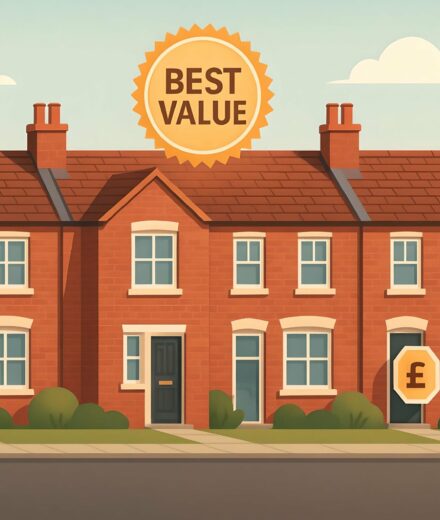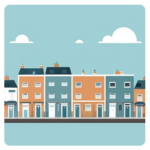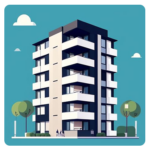

There’s something oddly satisfying about a city that isn’t rushing. Bournemouth’s housing trends have been growing with quiet confidence.
Our House Prices in Bournemouth page translates complex transactional data into a clean, comprehensible summary, ideal for those wanting to understand the current direction of the local market.
House Prices > Bournemouth
| Year | Average Price | Transactions |
|---|---|---|
| 2025 (proj.) | £335,900 | 3,674 |
| 2024 | £326,200 | 2,556 |
| 2023 | £328,500 | 2,920 |
| 2022 | £324,600 | 4,019 |
| 2021 | £312,200 | 4,991 |
| 2020 | £294,200 | 3,393 |
| 2019 | £278,000 | 3,754 |
| 2018 | £274,000 | 4,082 |
The surface numbers might tempt would-be buyers into thinking Bournemouth is enjoying a gently upward climb, but tug just a little at the threads and the picture gets noticeably messier. Average house prices have indeed crept upwards, with only the faintest of dips, but the story doesn’t end there. Cast an eye at transaction figures and things start to look a bit wobbly, even a touch storm-tossed compared to some steadier southern towns.
Here’s my critical take:
What’s the real danger here? Price tags may be growing, but the appetite for deals is evaporating for some types of property, and supply isn’t what it was even a handful of years ago. For anyone wary of mispricing – or potentially being “left holding the deckchair after the tide goes out” – it’s a smart call to check out How to Avoid Undervaluing Your Home in Bournemouth before swinging for the fences.
Bottom line? Bournemouth’s headline figures mask serious caution signals for both buyers and sellers. If you want to avoid going under with the next swell, keep your wits sharp and your feet dry.
Whether you're upsizing or downsizing, see what’s on offer among our houses for sale in Bournemouth.

Avg. Property Price: £469,700
Avg. Size of Property
1,221 sq/ft
Avg. Cost Per Sq/ft
£401 sq/ft
Total transactions
3,632 (since 2021)

Avg. Property Price: £338,200
Avg. Size of Property
959 sq/ft
Avg. Cost Per Sq/ft
£366 sq/ft
Total transactions
1,542 (since 2021)

Avg. Property Price: £254,500
Avg. Size of Property
769 sq/ft
Avg. Cost Per Sq/ft
£341 sq/ft
Total transactions
2,125 (since 2021)

Avg. Property Price: £228,200
Avg. Size of Property
699 sq/ft
Avg. Cost Per Sq/ft
£336 sq/ft
Total transactions
2,790 (since 2021)
Bournemouth’s housing market whispers tales of change, and the shift is anything but subtle. Prices, for one, have become quietly aspirational. Detached properties sweep in at the higher end of both size and price, nearly untouchable for many, while flats, once seen as the entry point, now increasingly stretch what most can afford. With flats sometimes costing less than a pint and a sandwich each square foot, these smaller dwellings draw budget-conscious buyers, but offer little of the breathing space people crave.
Transaction numbers drift quietly through the years, a reflection of the market’s understated stability. Detached homes, with their sprawling foundations, have witnessed the most change, rising to a rarefied tier. Even so, Bournemouth’s suburban streets don’t hum with the feverish trading of decades past. Instead, the pace is steady, echoing the gentle thrum of waves against the East Cliff on a cool spring morning.
Yet, as you wander through Boscombe or glance at the clifftop homes above the pier, one thing is perfectly clear: the climb is measured, not reckless. Property prices here are tiptoeing upward - not a sprint, but a steady and occasionally sentimental shuffle, like the Bournemouth Air Festival crowd heading slowly home at sunset. Value hunters, as ever, are forced into compromises, trading square footage for location or condition, and often stretching budgets that once went much further.
If you are trying to unravel what makes some neighbourhoods so persistently out-of-reach while others remain attainable, see the smartest streets to buy property in Bournemouth this year.
| District | Avg Price (£) | Transactions |
|---|---|---|
| BH1 | £230,100 | 3,627 |
| BH2 | £230,200 | 2,089 |
| BH3 | £443,700 | 622 |
| BH4 | £305,400 | 1,965 |
| BH5 | £274,700 | 1,917 |
| BH6 | £390,200 | 3,181 |
| BH7 | £352,400 | 1,373 |
| BH8 | £304,200 | 3,242 |
| BH9 | £313,800 | 3,446 |
| BH10 | £315,900 | 2,261 |
| BH11 | £299,900 | 2,223 |
Bournemouth’s property prices land all over the map, defined by postcode quirks, demand hotspots and the town’s distinctive charms. You will not find a neat, tidy middle – prices swing sharply between compact city centre stock and the coastal avenues of Boscombe East and Talbot Woods.
Entry pricing is southern coastal, not northern bargain. The central BH1 and BH2 districts cluster just above £230,000. These neighbourhoods carry noticeably high transaction counts. Flats dominate, pulled along by solid investor interest and the constant churn of first-time buyers and renters. We often see swift turnover and lively foot traffic here. For those priced out of leafier ends, these central postcodes function as a practical harbour – close to amenities, cheaper, not short on character.
Prestige carries a weighty premium. Just shifting west, BH3 soars, homes hovering above £440,000 – almost double the core. Sale numbers drop, as does mainstream accessibility. This is Bournemouth’s leafy heart, where larger detached homes line tranquil streets and traditional demand remains robust. At M0VE, we have observed family-sized properties here sell with little compromise made on value. Want more detail on pricing strategy? Read The Homeowner’s Guide to Pricing Property in Bournemouth.
Meanwhile, the eastern BH6 district commands robust four-hundred-thousand-plus averages, its coastal location and wider homes shaping strong, consistent demand. Stepping further north and west, prices moderate. BH8 to BH11, spanning Southbourne to Kinson, fill the spectrum from just under £300,000 to just below £316,000. These are classic middle-market suburbs – family territory, diverse housing stock, and an eclectic blend of pace and peace. Alongside, transaction counts here stay lively and resilient, marking these spots as Bournemouth’s solid performers.
The takeaway is simple. District defines both price and pace in Bournemouth. Seek prestige by the pines, or lean into the energetic, affordable core – each pocket comes with its own trade-offs and temptations. For buyers, subtle differences between postcodes can mean the difference between stretching the budget and bagging a smart-value family home.
Please also check out the following areas in Bournemouth for further insights:
| City | Avg Price (£) | Transactions |
|---|---|---|
| Poole | £339,400 | 14,450 |
| Ferndown | £392,400 | 2,539 |
| Christchurch | £407,700 | 5,121 |
| Broadstone | £475,200 | 1,181 |
| Wimborne | £408,700 | 3,618 |
| Ringwood | £428,000 | 1,893 |
| New Milton | £375,300 | 2,562 |
| Verwood | £390,500 | 1,640 |
| Swanage | £399,100 | 1,231 |
| Wareham | £371,900 | 1,228 |
Bournemouth’s property market often feels as unpredictable as the weather on Boscombe Pier. Compared to its coastal cousins and leafy neighbours, a few patterns jump out – and if you’re eyeing a move, these differences matter.
The spotlight here falls squarely on pricing and volume. While some nearby hotspots command eye-watering figures, Bournemouth typically lands in the middle ground for both price and activity. That’s a sweet spot for many buyers, but there’s more to unpack.
With that said, house hunting in this pocket of Dorset is rarely plain sailing. We’ve spotted plenty of buyers setting their sights on the coast, only to find that timing is everything – buying in Bournemouth today can feel a bit like grabbing the last deckchair on a sunny beach. If you want a home in this area, you’ll need to paddle fast and have your deposit ready.
As locals like to say, “Move quickly, or you’ll miss your wave.” We’re here to help you catch it.
Please note, these comparisons focus just on average price points and transaction activity.
Trends could appear less clear without adjusting for size or square foot price. For detailed comparisons, head to our blog.
Each estimate is crafted using corrected figures drawn from real sales and energy reports. You get more truth, less padding. Read more about our method
Our site uses cookies. By using this site, you agree to the Privacy Policy and Terms of Use.